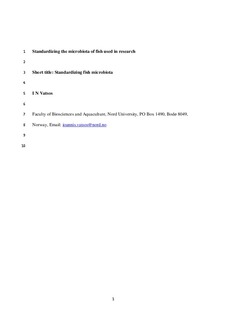Standardizing the microbiota of fish used in research
Journal article, Peer reviewed

Åpne
Permanent lenke
http://hdl.handle.net/11250/2433488Utgivelsesdato
2016Metadata
Vis full innførselSamlinger
Originalversjon
Vatsos, I. (2016). Standardizing the microbiota of fish used in research. Laboratory Animals, 51(4), 353-364. doi: 10.1177/0023677216678825Sammendrag
Little attention has been paid to the effects of fish microbiotas on the reproducibility and comparability of fish studies so far. Extrinsic and intrinsic factors, such as water quality, environmental microbial populations, diet, host genetic profile, gender, age and stress status, affect fish microbiotas and create significant inter- and intra-species variations. Fish microbiotas play critical roles in many key aspects of host physiology, such as protection against pathogens, digestion and development of the digestive tract and the local immune system. Thus, greater effort should be invested in standardizing the microbiological profiles of research fish. In this context, issues requiring consideration include the establishment of isogenic and isobiotic fish lines, the standardization of rearing conditions and the development of appropriate tests to adequately describe microbial populations. There are many challenges involved in each of these issues, and the research community must decide which aspects should be standardized for each species and each type of research. For all studies in which microbiota is expected to exert an influence, thorough reporting is of paramount importance. Every step towards standardization increases study quality and simultaneously contributes to reducing the number of fish used in research, which is a legal and ethical obligation.
Beskrivelse
Author's accepted version (post-print).